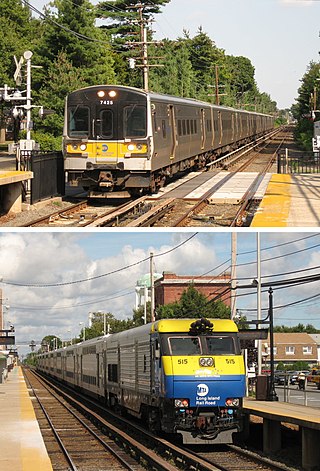
The Long Island Rail Road, often abbreviated as the LIRR, is a railroad in the southeastern part of the U.S. state of New York, stretching from Manhattan to the eastern tip of Suffolk County on Long Island. The railroad currently operates a public commuter rail service, with its freight operations contracted to the New York and Atlantic Railway. With an average weekday ridership of 354,800 passengers in 2016, it is the busiest commuter railroad in North America. It is also one of the world's few commuter systems that runs 24/7 year-round. It is publicly owned by the Metropolitan Transportation Authority, which refers to it as MTA Long Island Rail Road. In 2023, the system had a ridership of 75,186,900, or about 253,800 per weekday as of the fourth quarter of 2023.

Richmond Hill is a commercial and residential neighborhood located in the southeastern section of the New York City borough of Queens. The area borders Kew Gardens and Forest Park to the north, Jamaica and South Jamaica to the east, South Ozone Park to the south, and Woodhaven and Ozone Park to the west. The neighborhood is split between Queens Community Board 9 and 10.
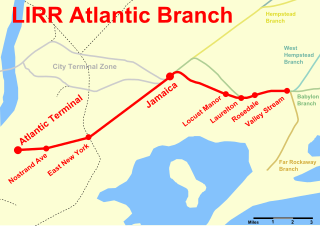
The Atlantic Branch is an electrified rail line owned and operated by the Long Island Rail Road in the U.S. state of New York. It is the only LIRR line with revenue passenger service in the borough of Brooklyn.

The Morris Park Facility is a maintenance facility of the Long Island Rail Road in Queens, New York City. It includes two employee-only side platforms on the Atlantic Branch named Boland's Landing. Two wooden platforms, each two cars long, exist on the two-track line, with a flashlight for workers to signal trains to stop.

The City Terminal Zone is the set of Long Island Rail Road lines within New York City west of Jamaica station, except the Port Washington Branch.

The Babylon Branch is a rail service operated by the Long Island Rail Road in the U.S. state of New York. The term refers to the trains serving Montauk Branch stations from Valley Stream east to Babylon; in other words, the Babylon Branch is a rail service rather than an actual track. The electrification of the Montauk Branch ends east of the Babylon station, so the Babylon Branch is mostly served by electric trains.

The Montauk Branch is a rail line owned and operated by the Long Island Rail Road in the U.S. state of New York. The line runs the length of Long Island, 115 miles (185 km) from Long Island City to Montauk. However, in LIRR maps and schedules for public use, the term Montauk Branch refers to the line east of Babylon; service from Jamaica to Babylon is covered by separate Babylon Branch schedules, while the line west of Jamaica is currently unused for passenger service. A select number of Montauk Branch trains operate via the Main Line during peak hours.

The Kew Gardens station is a station on the Main Line of the Long Island Rail Road (LIRR). It is located in the Kew Gardens neighborhood of Queens, New York City, near Austin Street and Lefferts Boulevard. The station is located within the City Terminal Zone, part of LIRR fare zone 1. It contains four tracks and two side platforms for the outermost tracks.
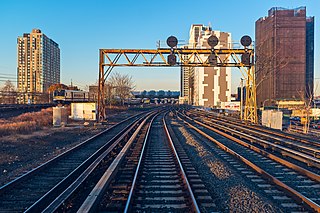
The Main Line is a rail line owned and operated by the Long Island Rail Road in the U.S. state of New York. It begins as a two-track line at Long Island City station in Long Island City, Queens, and runs along the middle of Long Island about 95 miles (153 km) to Greenport station in Greenport, Suffolk County. At Harold Interlocking approximately one mile east of Long Island City, the tracks from the East River Tunnels and 63rd Street Tunnel into Manhattan intersect with the Main Line, which most trains use rather than using the Long Island City station.
The Long Island Rail Road is a railroad owned by the Metropolitan Transportation Authority in the U.S. state of New York. It is the oldest United States railroad still operating under its original name and charter. It consolidated several other companies in the late 19th century. The Pennsylvania Railroad owned the Long Island Rail Road for the majority of the 20th century and sold it to the State in 1966.

Dunton was a ground-level station on the Long Island Rail Road's Montauk Branch, Atlantic Branch, and later the Main Line in Dunton, Queens, New York City, United States. It was closed in 1939 when the Atlantic Branch was placed in a tunnel east of East New York.
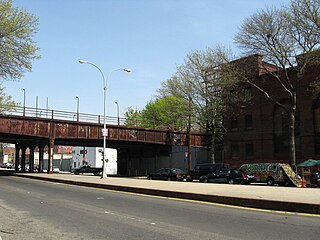
The Rockaway Beach Branch was a rail line owned and operated by the Long Island Rail Road in Queens, New York City, United States. The line left the Main Line at Whitepot Junction in Rego Park heading south via Ozone Park and across Jamaica Bay to Hammels in the Rockaways, turning west there to a terminal at Rockaway Park. Along the way it connected with the Montauk Branch near Glendale, the Atlantic Branch near Woodhaven, and the Far Rockaway Branch at Hammels.
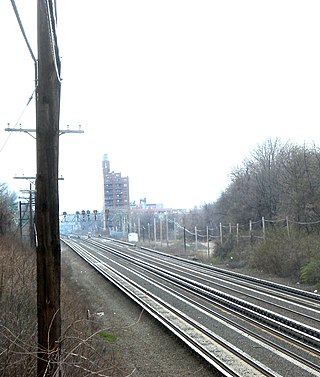
Rego Park is a former Long Island Rail Road station. It was made of wood, unlike most other stations that were concrete. The station opened in May 1928 with two side platforms outside the two Rockaway Beach Branch tracks that bracketed the four-track Main Line, so only Rockaway trains stopped there. After the Rockaway Trestle fire in 1950, the line was closed station by station. The station closed on June 8, 1962, one day before the Rockaway Beach Branch was abandoned. Nothing remains at the site today.
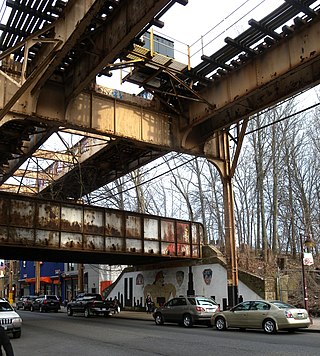
The Brooklyn Manor station was a station on the Long Island Rail Road's Rockaway Beach Branch located on the south side of Jamaica Avenue at 100th Street, straddling the border between Richmond Hill and Woodhaven in Queens, New York City. The station name referred to the nearby Brooklyn Manor section of Woodhaven, originally a 603-lot development bounded by Woodhaven Boulevard to the west, 96th/98th Streets to the east, Forest Park to the north, and Jamaica Avenue to the south. The station opened in January 1911, and was constructed as a replacement for the Brooklyn Hills station, which was located 3,000 feet (910 m) to the north. This station closed along with the rest of the Rockaway Beach Branch in 1962, and was subsequently demolished.

The Clarenceville station was on the Atlantic Branch of the Long Island Rail Road, located on Atlantic Avenue west of 111th Street in the Richmond Hill section of Queens, New York City. Richmond Hill station to the north, at Jamaica Avenue and Lefferts Boulevard, was also originally named Clarenceville Station when it opened in 1868, but that name was changed in 1871.
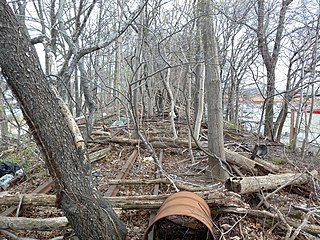
Parkside is a former elevated Long Island Rail Road (LIRR) station on the north side of Metropolitan Avenue on the border of the Rego Park, Forest Hills, and Glendale neighborhoods in Queens, New York City. Opened in 1927, the wooden station was part of the Rockaway Beach Branch and was the northernmost station on the branch before the junction with the Main Line at Rego Park Station and the terminus of the line at Grand Street station in Elmhurst. It also had a connecting spur to the Montauk Branch east towards Richmond Hill station. The station was closed in 1962, twelve years after the LIRR had abandoned the Rockaway portions of the line.
Central Railroad of Long Island was built on Long Island, New York, by Alexander Turney Stewart, who was also the founder of Garden City. The railroad was established in 1871, then merged with the Flushing and North Side Railroad in 1874 to form the Flushing, North Shore and Central Railroad. It was finally acquired by the Long Island Rail Road in 1876 and divided into separate branches. Despite its short existence, the CRRLI had a major impact on railroading and development on Long Island.
Higbie Avenue was a railroad station along the Atlantic Branch of the Long Island Rail Road, in Queens, New York City. The station was located on 140th Avenue and Edgewood Avenue in the Springfield section of Queens, New York City between Locust Manor and Laurelton stations.
Richmond Hill Historic District is a national historic district in Richmond Hill, Queens, New York. It is bounded to the north by Park Lane South, to the east by 118th Street, to the south by Myrtle Avenue. The district includes 200 contributing buildings built between 1890 and 1915 next to the former South Side Railroad line and the Richmond Hill station at Hillside Avenue, shaped roughly like a triangle. They consist mainly of architectural styles dating back to an earlier time of Academic Eclecticism in home building and were constructed for railroad commuters. Most of the contributing properties were planned as suburbs to Brooklyn and Manhattan. It also included smaller houses built between 1917 and 1930 at the beginning of the Great Depression.


















